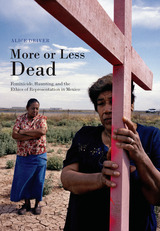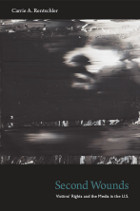2 books about Victims of crimes in mass media

More or Less Dead
Feminicide, Haunting, and the Ethics of Representation in Mexico
Alice Driver
University of Arizona Press, 2015
In Ciudad Juárez, Mexico, people disappear, their bodies dumped in deserted city lots or jettisoned in the unforgiving desert. All too many of them are women.
More or Less Dead analyzes how such violence against women has been represented in news media, books, films, photography, and art. Alice Driver argues that the various cultural reports often express anxiety or criticism about how women traverse and inhabit the geography of Ciudad Juárez and further the idea of the public female body as hypersexualized. Rather than searching for justice, the various media—art, photography, and even graffiti—often reuse victimized bodies in sensationalist, attention-grabbing ways. In order to counteract such views, local activists mark the city with graffiti and memorials that create a living memory of the violence and try to humanize the victims of these crimes.
The phrase “more or less dead” was coined by Chilean author Roberto Bolaño in his novel 2666, a penetrating fictional study of Juárez. Driver explains that victims are “more or less dead” because their bodies are never found or aren’t properly identified, leaving families with an uncertainty lasting for decades—or forever.
The author’s clear, precise journalistic style tackles the ethics of representing feminicide victims in Ciudad Juárez. Making a distinction between the words “femicide” (the murder of girls or women) and “feminicide” (murder as a gender-driven event), one of her interviewees says, “Women are killed for being women, and they are victims of masculine violence because they are women. It is a crime of hate against the female gender. These are crimes of power.”
More or Less Dead analyzes how such violence against women has been represented in news media, books, films, photography, and art. Alice Driver argues that the various cultural reports often express anxiety or criticism about how women traverse and inhabit the geography of Ciudad Juárez and further the idea of the public female body as hypersexualized. Rather than searching for justice, the various media—art, photography, and even graffiti—often reuse victimized bodies in sensationalist, attention-grabbing ways. In order to counteract such views, local activists mark the city with graffiti and memorials that create a living memory of the violence and try to humanize the victims of these crimes.
The phrase “more or less dead” was coined by Chilean author Roberto Bolaño in his novel 2666, a penetrating fictional study of Juárez. Driver explains that victims are “more or less dead” because their bodies are never found or aren’t properly identified, leaving families with an uncertainty lasting for decades—or forever.
The author’s clear, precise journalistic style tackles the ethics of representing feminicide victims in Ciudad Juárez. Making a distinction between the words “femicide” (the murder of girls or women) and “feminicide” (murder as a gender-driven event), one of her interviewees says, “Women are killed for being women, and they are victims of masculine violence because they are women. It is a crime of hate against the female gender. These are crimes of power.”
[more]

Second Wounds
Victims’ Rights and the Media in the U.S.
Carrie A. Rentschler
Duke University Press, 2011
The U.S. victims’ rights movement has transformed the way that violent crime is understood and represented in the United States. It has expanded the concept of victimhood to include family members and others close to direct victims, and it has argued that these secondary victims may be further traumatized through their encounters with insensitive journalists and the cold, impersonal nature of the criminal justice system. This concept of extended victimization has come to dominate representations of crime and the American criminal justice system. In Second Wounds, Carrie A. Rentschler examines how the victims’ rights movement brought about such a marked shift in how Americans define and portray crime. Analyzing the movement’s effective mobilization of activist networks and its implementation of media strategies, she interprets texts such as press kits, online victim memorials, and training materials for victims’ advocates and journalists. Rentschler also provides a genealogy of the victims’ rights movement from its emergence in the 1960s into the twenty-first century. She explains that while a “get tough on crime” outlook dominates the movement, the concept of secondary victimization has been invoked by activists across the political spectrum, including anti–death penalty advocates, who contend that the families of death-row inmates are also secondary victims of violent crime and the criminal justice system.
[more]
READERS
Browse our collection.
PUBLISHERS
See BiblioVault's publisher services.
STUDENT SERVICES
Files for college accessibility offices.
UChicago Accessibility Resources
home | accessibility | search | about | contact us
BiblioVault ® 2001 - 2024
The University of Chicago Press









